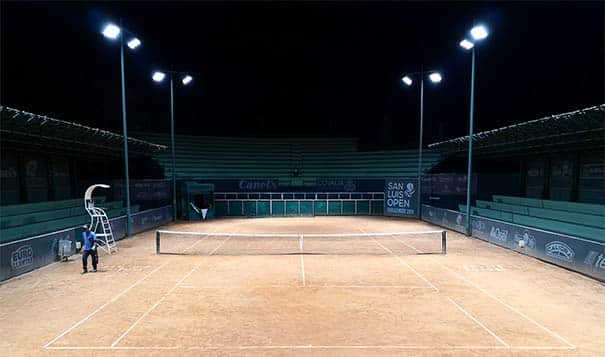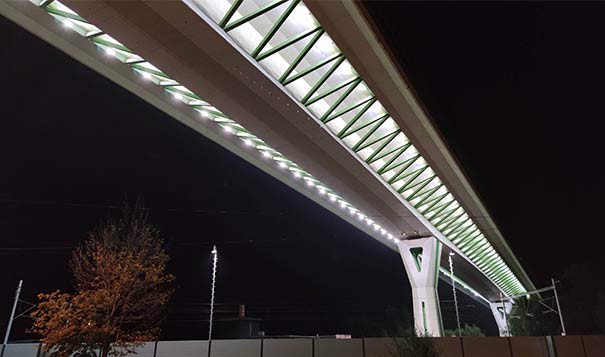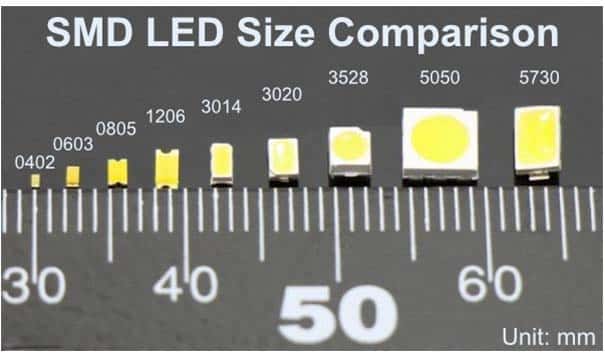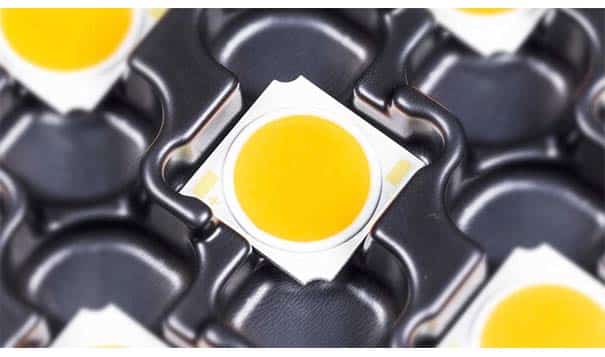Something you should know about LEDs
Introduction
A light-emitting diode is a semiconductor light source that emits light when an electric current flows through it. It is commonly known as LED and plays an important role in our daily life. LEDs do many different jobs in a variety of devices such as LED light, LED display, LED traffic light, etc. Hope that we can give you an understanding of the classification (type), advantages, and applications of LEDs through this article.


Type of LEDs
According to the difference of LED chip packages, the various types of LEDs include COB, SMD, MCOB, and MCCOB.
SMD is short for Surface mounted diode which is a standalone chip on a ceramic base. It can be used for white LED lamps and LED strip lights. Now it’s very common in light industrial applications such as street light, floodlight, and linear light.

COB is short for chip on board. This kind of LED comes as a high-powered chip that is wired on a printed circuit board with optimal thermal management. It’s normally used in LED downlight, LED tracking lights.

Except for SMD and COB, MCOB and MCCOB are becoming common in LED lighting application now.
MCOB is short for multiple chips onboard LED. They are multiple COB LEDs integrated to form a single chip. This technology is used in LED bulbs and tubes. MCCOB is short for multiple chips and cups on board. They are normally used for high bay fixtures and some floodlights.
As we introduced before, we can divide the LEDs mainly into SMD, COB, MCOB, and MCCOB based on the different structures of LEDs. However, LEDs can be divided into three different categories according to their power. It includes Low-Power, Mid-Power, and High-Power.
Power is found mathematically by forwarding voltage and drive current. For example, Lumileds 3030 LEDs with 5.8V consumes approximately 0.7W when driven with a current of 120 mA.
As Lumileds said, they classified with the standard as follows. LEDs with power below 0.1W in the Low-Power class. LEDs with a power range of 0.1W to 1.0W are known as Mid-Power, while those with a power range of 1W to 3W are known as High-Power LEDs.
But different supplier has a different standard. Osram told us, LEDs with power below 0.2W are called Low-Power. LEDs with power between 0.2W and 1.0W are called Mid-Power. And LEDs with power between 1.0W and 4.0W are called High-Power. For 4W LED chips of Cree, they still called it Mid-Power.
Advantages and disadvantages of SMD and COB LEDs.
Based on different standards, the Type of LEDs can be SMD, COB, or others. Here mainly introduces the advantages and disadvantages of SMD and COB.
SMD refers to the term “Surface Mounted Device” LEDs, which are the utmost shared LEDs in the market. There are multiple sizes of SMD LED chips: 2835, 3535, 3030, 3014, 5050, 5630; they are termed according to their dimensions: length and width. For instance, the size of the 3535 is 3.5 x 3.5mm, 3030 is 3.0 x 3.0mm, 5050 is 5.0 x 5.0mm. Below are the advantages and disadvantages.
Advantages of SMD LEDs
- SMDs are more efficient than COBs because the light source produces higher lumens per watt, which means that they produce more light with a lower wattage.
- They produce a wider beam of light which is spread over a greater area. This means that less material is needed for the heat sink, which in turn means that they are more economical.
- SMD lamps produce a wide spread of light which is suitable for area lighting.
- Since there are many chips on one PCB, as time went by, if one of the chips is broken, the other LED chips will still work by designing a special circuit.
- High reliability, strong vibration resistance, and low defect rate in solder joint points.
- Because SMD LEDs are with relatively small size and have less weight, it’s easy to achieve automation, which improves production efficiency. Then materials, energy, equipment, manpower, time, will also be saved.
- With small size SMD LEDs, it makes SMD LEDs more flexible in lamp design. And with less weight and good heat dissipation (less heatsink), the lamps are with lower weight which is competitive in some tender and also good for safety. Due to their power limitations, class 2 electrical are considered safe from a fire initiation point of view and provide acceptable protection against electric shock. Therefore, it is recommended to choose class 2 electrical for outdoor lighting.
Disadvantages of SMD LEDs
The manufacturing procedure to make SMD is more expensive because the SMD diodes (LED chips) are machine printed on a PCB board.
COB is the short form of "Chip on Board". Manifold LED chips are packed together as a single lighting module and it looks like a panel when it lights up. Different from SMD, COB has more diodes. COB has a printed circuit board on its substrate and diode chips are arranged in parallel or/and in series, based on the circuit of the PCB. The substrate can be either in aluminum or ceramic. Below are the advantages and disadvantages.
Advantages of COB LEDs
- Cheap
- As COB LED chip is placed on the printed circuit board, and the electrical connection between the chip and the substrate is realized by a wire stitching method, and is covered with a resin. So reliability is insured.
- With relative high CRI and uniformity lighting COB is suitable for indoor lighting.
- COB is easy for installation and use. These reduce the difficulty of lamp design and save lamp assembling cost.
Disadvantages of COB LEDs
- As the single cluster of LED’s are mounted in one point, they require greater cooling, so a larger heat sink, usually made of aluminum, must be mounted to dissipate the heat. As more material is required to manufacture a COB LED heat sink, this usually increases the cost. But even using more materials, the dissipation problem of COB can still not be solved.
- Comparing to SMD, COB has more LEDs at same area as SMD, so it has the disadvantage like spotlight and glare. But with special cover and plus its uniformity lighting, it’s also well used in indoor lighting.
- Few street lights with COB LEDs are with modular design, this makes COB street light are not easy for maintenance. Additionally, if one COB fails, the power of lamps will greatly reduce and then we have to maintenance this lamp.
Applications of SMD and COB LEDs
SMD LEDs are one of the most common types of lighting that we have today. They are used in many outdoor applications like street lights, floodlights, high bay lights, canopy lights, linear lights.
COB LED lights are used in numerous applications, including COB street lighting, tracking light, downlight, spotlight, and low bay light.
So, their application scenarios are not fixed. For example, Both COB and SMD can be used in street lighting and high bay light. While COB is much common in downlight and tracking light, and SMD are much common high bay light, street lighting.
Summary
Below we listed the differences between SMD and COB. But it will certainly be as below. For example, some COB LEDs are with high efficient than SMD LEDs. Or SMD will be a cheaper solution which is used in street light applications. Or even a downlight with COB can get a better performance in heat dissipation.
| SMD LED lights | COB LED lights | |
|---|---|---|
| Number of diodes | Normally up to 3 or 4 diodes | Multiple diodes, 9 or more |
| Appearance | Small, looks like a whole unit | Big, diodes sometimes are visible |
| Quality of light | Wide beam angle with some glare. | Relatively high CRI and uniformity lighting |
| Lumens per watt ratio | Normally higher than COB | Relatively lower efficiency |
| Size of the heat sink | Small heat sink | Need a big heat sink |
| Technology | They require mounting then reflow soldering on the PCB | It does not require any mounting or reflow soldering |
| Manufacturing costs | Relatively high | Relatively low |
Comments
Post a Comment